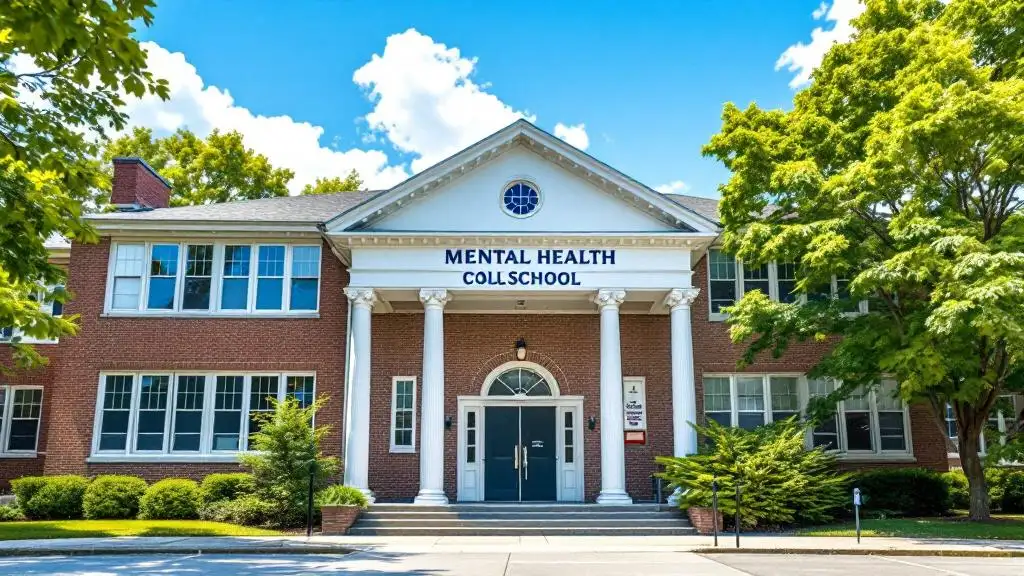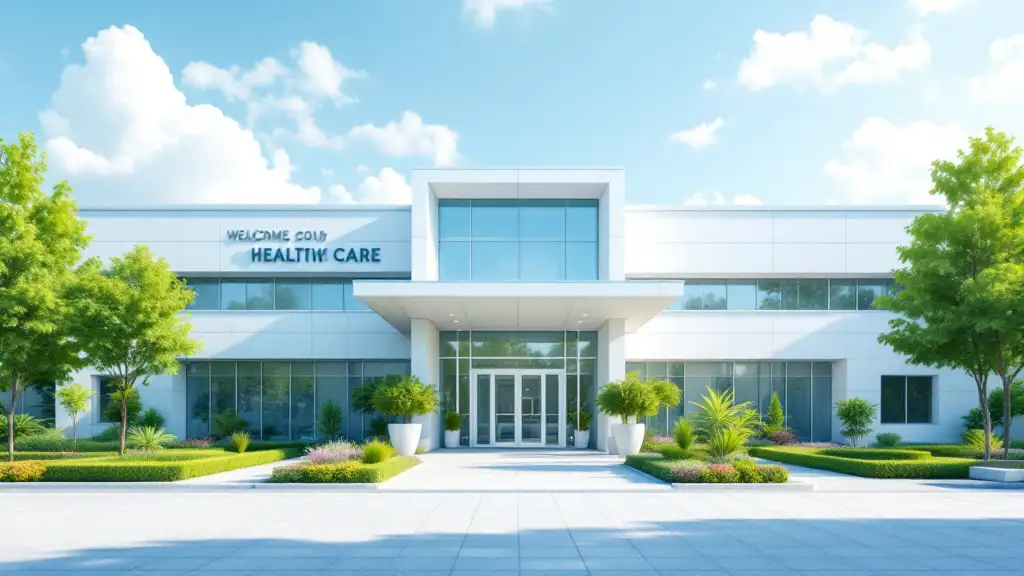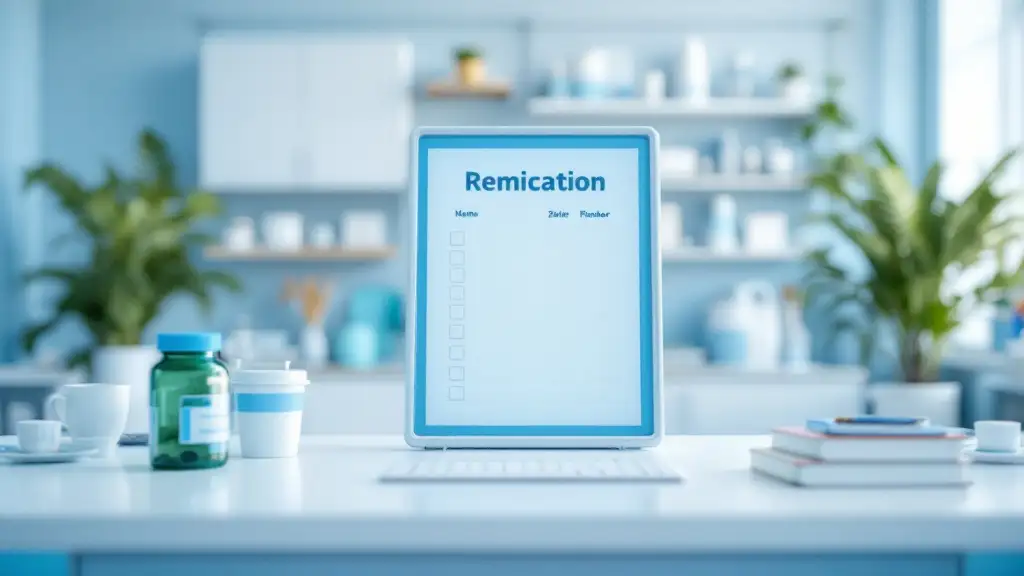The Promise of Group Therapy in PTSD Recovery
Post-Traumatic Stress Disorder (PTSD) is a complex condition affecting millions worldwide. While individual therapies like cognitive-behavioral therapy and medication are mainstays in treatment, group therapy emerges as a powerful complementary approach. Leveraging shared experiences, social support, and diverse coping strategies, group therapy can significantly bolster PTSD recovery processes. This article explores how group therapy functions, its various models, and its profound benefits, supported by extensive research and clinical experience.
Understanding Group Therapy as a Key PTSD Treatment Modality
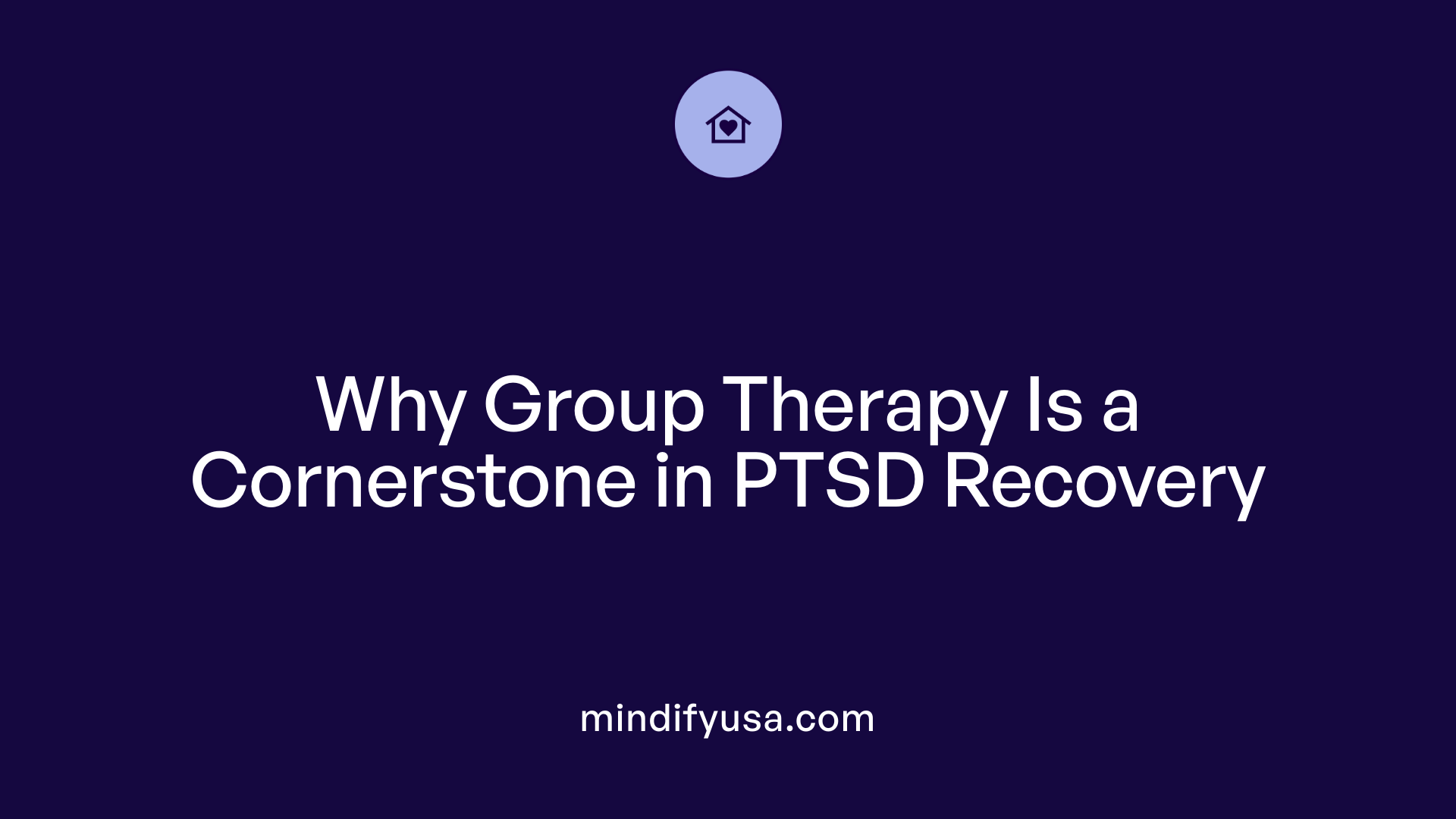
What are the recommended treatments for PTSD?
Trauma-focused psychotherapies are regarded as the most effective approaches in treating PTSD. Among these, Cognitive Processing Therapy (CPT), Prolonged Exposure (PE), and Eye Movement Desensitization and Reprocessing (EMDR) stand out due to extensive research backing their efficacy. These therapies typically involve a series of 12-16 weekly sessions where individuals confront trauma-related memories, learn coping skills, and challenge distorted beliefs stemming from their experiences.
CPT emphasizes restructuring negative thought patterns related to trauma, while PE focuses on exposure to trauma memories in a controlled manner to reduce fear and avoidance. EMDR helps reprocess traumatic memories through bilateral sensory stimulation, such as eye movements, leading to decreased PTSD symptoms.
In addition to talk therapies, medication plays a supportive role. Selective serotonin reuptake inhibitors (SSRIs) like sertraline, paroxetine, and the antidepressant venlafaxine are commonly prescribed to alleviate symptoms, especially when psychotherapy alone is insufficient or not preferred. Combining medications with psychotherapy can enhance treatment outcomes, particularly for individuals with persistent symptoms or comorbid conditions.
Overall, the mainstay of PTSD treatment emphasizes a combination of trauma-specific therapies supported by pharmacological options as needed. This multi-modal approach aims to help individuals process traumatic memories, develop effective coping mechanisms, and improve overall functioning.
How does group therapy compare with other treatment options?
Research consistently demonstrates that group therapy is a highly effective modality for managing PTSD symptoms. Meta-analyses of randomized controlled trials show that group psychotherapy can produce significant symptom reductions comparable to individual treatments such as cognitive-behavioral therapy. For example, exposure-based cognitive-behavioral group therapy (group CBT) has shown a large effect size in alleviating PTSD symptoms.
One of the main advantages of group therapy is the peer support it fosters. Participants connect with others who share similar trauma experiences, which helps reduce feelings of isolation and stigma. The social support offered in these settings enhances feelings of validation and understanding, vital components in trauma recovery.
While empirical evidence is promising, the research on group therapy is somewhat limited due to methodological variations and a relative scarcity of rigorous large-scale studies. Consequently, no specific group therapy modality currently holds official recognition as an evidence-based treatment, unlike individual CPT or PE. Nonetheless, models such as Present-Centered Therapy and trauma-focused protocols demonstrate considerable promise.
In summary, group therapy offers an accessible, supportive alternative or complement to individual treatments. It provides shared exposure, skill-building opportunities, and community support, making it a valuable component of comprehensive PTSD care. Still, further high-quality research is needed to establish its definitive comparative effectiveness and to identify best practices for different patient populations.
Additional Insights on Group Therapy for PTSD
Beyond symptom reduction, group therapy helps individuals understand how trauma influences their thoughts and behaviors. It teaches coping strategies, enhances emotional regulation, and promotes self-awareness. Participants often report benefits like forgiveness, anger management, improved social skills, and resilience.
Engaging in group therapy also encourages diverse perspectives, broadening survivors’ understanding of their trauma and recovery options. It fosters a sense of belonging and community, which is crucial given the social withdrawal often associated with PTSD.
Research indicates that when facilitated by trained professionals, group therapy can have lasting positive effects, including decreased symptom severity and improved quality of life. Online formats are emerging as effective alternatives, expanding access and convenience.
In primary care settings, preliminary studies show that structured group models tailored for PTSD can be effective, although more extensive research is needed. Support groups and trauma-specific programs serve as valuable adjuncts to formal therapy, providing ongoing peer support and encouragement.
Overall, the combination of evidence-based trauma therapies, social support, and community connection makes group therapy a powerful tool in PTSD recovery efforts.
The Spectrum of Group Therapy Models for PTSD
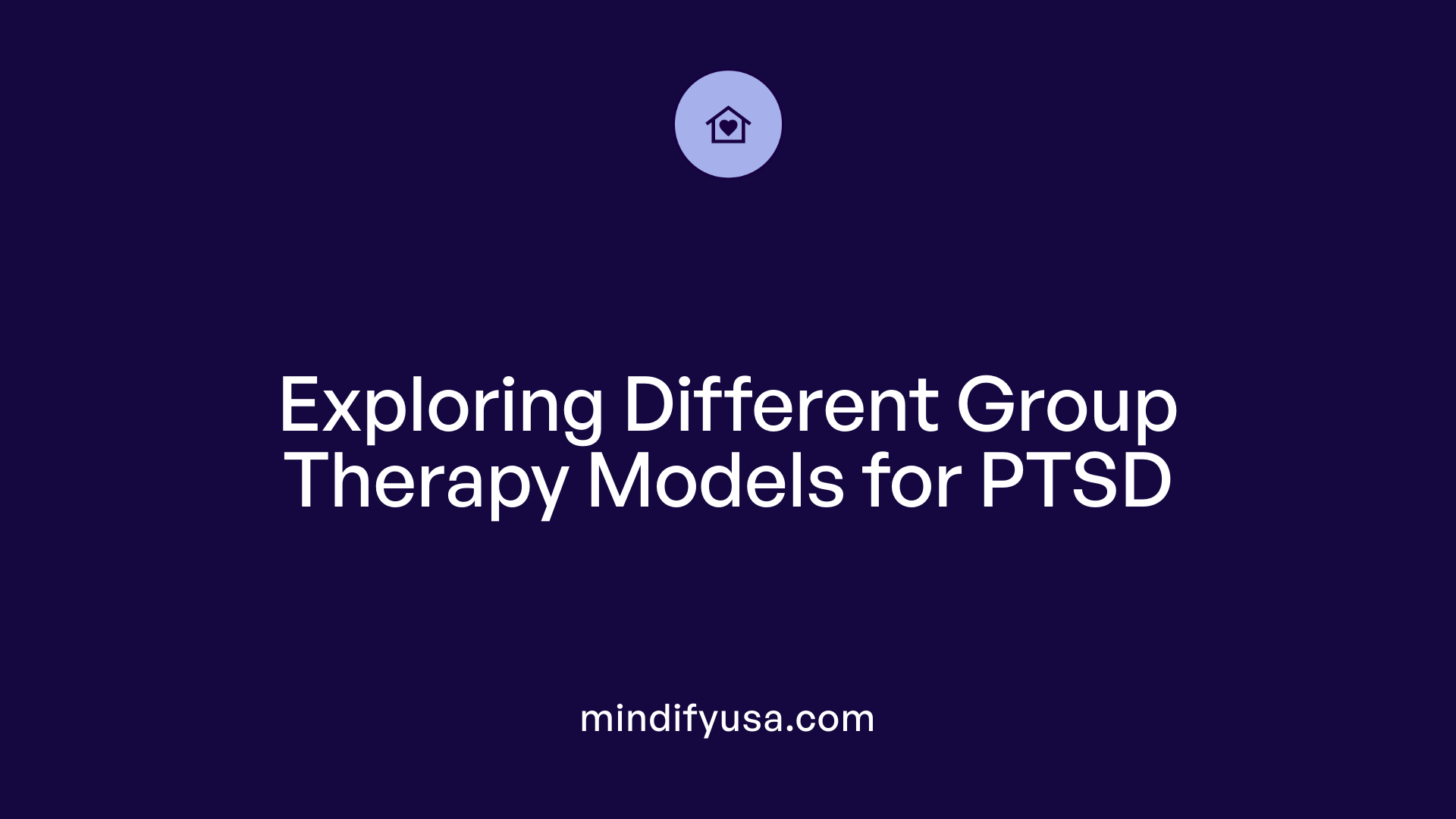
What are the different types and models of group therapy used for PTSD?
Group therapy offers a variety of approaches tailored to address the complex symptoms associated with PTSD. These models can be broadly categorized based on their therapeutic focus—whether they emphasize trauma processing, emotional support, psychoeducation, or relational dynamics.
One of the most well-known trauma-focused approaches is Cognitive Processing Therapy (CPT). CPT aims to help participants challenge and modify unhelpful thoughts related to their trauma. When adapted for group settings, CPT allows individuals to share experiences while learning cognitive restructuring techniques in a collaborative environment.
Prolonged Exposure (PE) therapy, another evidence-based model, focuses on gradually confronting trauma-related memories and triggers. In group settings, PE includes exercises such as exposure to trauma narratives and imagery within a controlled, supportive space.
Support groups serve as a different model, emphasizing emotional support, normalization of experiences, and social connection. These groups often foster empathy and understanding among members, which can significantly reduce feelings of isolation and shame.
Psychodynamic and interpersonal therapy groups explore internal conflict, emotional regulation, and relationship patterns associated with trauma. These models aim to deepen insight and promote healing through exploring underlying emotional issues.
Many programs employ hybrid models, integrating individual therapy with group sessions. For instance, Trauma Management Therapy (TMT) combines personalized treatment plans with group support to address both trauma symptoms and social functioning.
Psychoeducation groups are designed to impart knowledge about PTSD, its effects, and effective coping strategies. These are often used as adjuncts to more intensive trauma-focused therapies or as introductory sessions.
Another innovative model is the Trauma Information Group (TIG), which adopts a stage-based, relational approach. TIG emphasizes building social support networks and reducing trauma-related shame through relational healing.
Research indicates that these varied models are effective in reducing PTSD symptoms. Trauma-focused therapies like CPT and PE have consistently demonstrated large effect sizes in symptom reduction.
Supportive and psychoeducational groups help foster community, teach coping skills, and promote emotional resilience, which are essential for recovery.
In addition to these, newer approaches are exploring group treatments that incorporate mindfulness, art therapy, and resilience-building activities for comprehensive trauma recovery.
The diversity in models allows mental health professionals to tailor treatments to meet individual needs, trauma histories, and cultural contexts, enhancing the effectiveness of group therapy interventions for PTSD.
What types and models of group therapy are used for treating PTSD?
| Model Type | Description | Core Focus | Evidence of Effectiveness |
|---|---|---|---|
| Trauma-Focused Cognitive Behavioral Therapy (TF-CBT) | Adapts CBT techniques in group settings, targeting traumatic thoughts and exposure | Cognitive restructuring, exposure | High |
| Prolonged Exposure (PE) | Gradual exposure to trauma memories and triggers within a supportive group | Trauma confrontation, fear extinction | High |
| Support Groups | Peer-led groups providing emotional support and normalization | Emotional validation, social support | Moderate to High |
| Psychodynamic Groups | Exploring internal conflicts and emotional patterns related to trauma | Emotional insight, relational patterns | Moderate |
| Hybrid Models (e.g., TMT) | Combining individual and group therapies to address symptoms and social functioning | Symptom management, social skills | Varies |
| Psychoeducation Groups | Providing information about PTSD and coping strategies | Knowledge, self-care skills | Supportive |
| Relational/Stage-Based Models (e.g., TIG) | Focusing on relational healing, reducing shame | Relational support, community building | Emerging |
Search query for more information
diverse models PTSD group therapy treatments approaches efficacy
Understanding the broad spectrum of treatment options enables clinicians to choose the most suitable approach for their clients. Each model offers unique strengths, and often, combining different methods can optimize recovery outcomes for individuals with PTSD.
Benefits and Proven Effectiveness of Group Therapy in PTSD Recovery
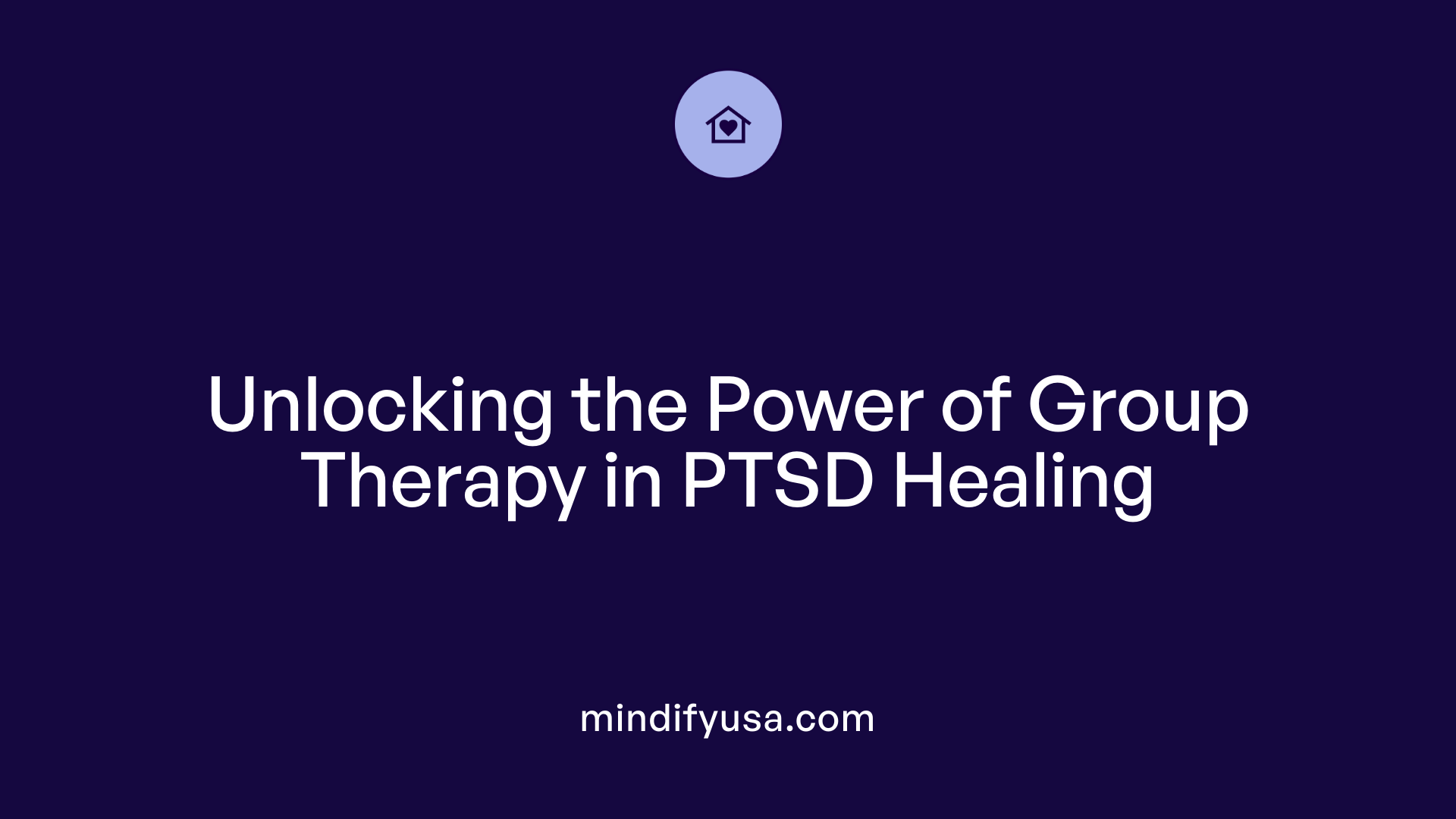
What are the benefits and effectiveness of group therapy for PTSD recovery?
Group therapy plays a vital role in aiding individuals recovering from Post-Traumatic Stress Disorder (PTSD). This approach provides a safe, supportive environment where participants can openly share their traumatic experiences, which is often the first step toward healing. Sharing in a group setting reduces feelings of isolation and stigma, as individuals realize they are not alone in their struggles. Connecting with others who have similar experiences fosters a sense of community, belonging, and mutual understanding.
Research studies, including meta-analyses of randomized controlled trials (RCTs), confirm that group therapy can significantly lower PTSD symptoms. For example, therapies such as trauma-focused cognitive-behavioral therapy (CBT) and exposure therapies, like Prolonged Exposure (PE) and Cognitive Processing Therapy (CPT), have demonstrated large effect sizes in symptom reduction. In some cases, group therapy is as effective as individual therapy, but often at a lower cost and with the added benefit of peer support.
The social support promoted by group therapy is fundamental. It helps individuals develop emotional resilience, normalize their reactions to trauma, and adopt effective coping mechanisms. Many veterans and trauma survivors report that group therapy enables them to regulate emotions better, forgive themselves and others, and face daily challenges with more confidence. The shared experiences and encouragement within the group foster hope and empowerment, facilitating long-term recovery.
While the quality and structure of group therapy—such as the type of approach, group composition, and facilitator expertise—influence outcomes, evidence consistently supports its efficacy. When occurring within well-managed, professional settings, group therapy becomes a cornerstone in comprehensive PTSD treatment plans, complementing individual therapy and medication options.
What mechanisms and processes are involved?
Group therapy for PTSD involves several psychological and social processes that contribute to its effectiveness. Establishing a foundation of trust and safety is critical, allowing participants to express traumatic memories without fear of judgment. Techniques like trauma narratives, cognitive restructuring, psychoeducation, and skills training enable individuals to process their trauma constructively.
Social mechanisms also play a crucial role. Shared group membership fosters social identification, boosting emotional support and reducing feelings of helplessness. Group cohesion, which refers to the sense of solidarity and mutual support, directly correlates with symptom improvement. Factors like trauma type, gender composition, and group size influence the dynamics and outcomes.
The processes fostered in group therapy include emotional expression, relational repair, stabilization, and empowerment. These help trauma survivors rebuild trust, regulate emotions, and develop new coping skills. Additionally, participation promotes normalization of trauma reactions, helping individuals understand that their responses are common and understandable.
Further, group interactions facilitate social learning, whereby members learn different coping strategies and perspectives from others. This diverse exchange broadens understanding and expands individual resilience. Overall, these social and cognitive mechanisms combine to buffer the traumatic impact and promote recovery.
While these processes demonstrate promising results, ongoing research continues to explore optimal methods, group compositions, and active ingredients that maximize therapeutic benefits for individuals suffering from PTSD.
Factors Influencing the Success of Group Therapy for PTSD
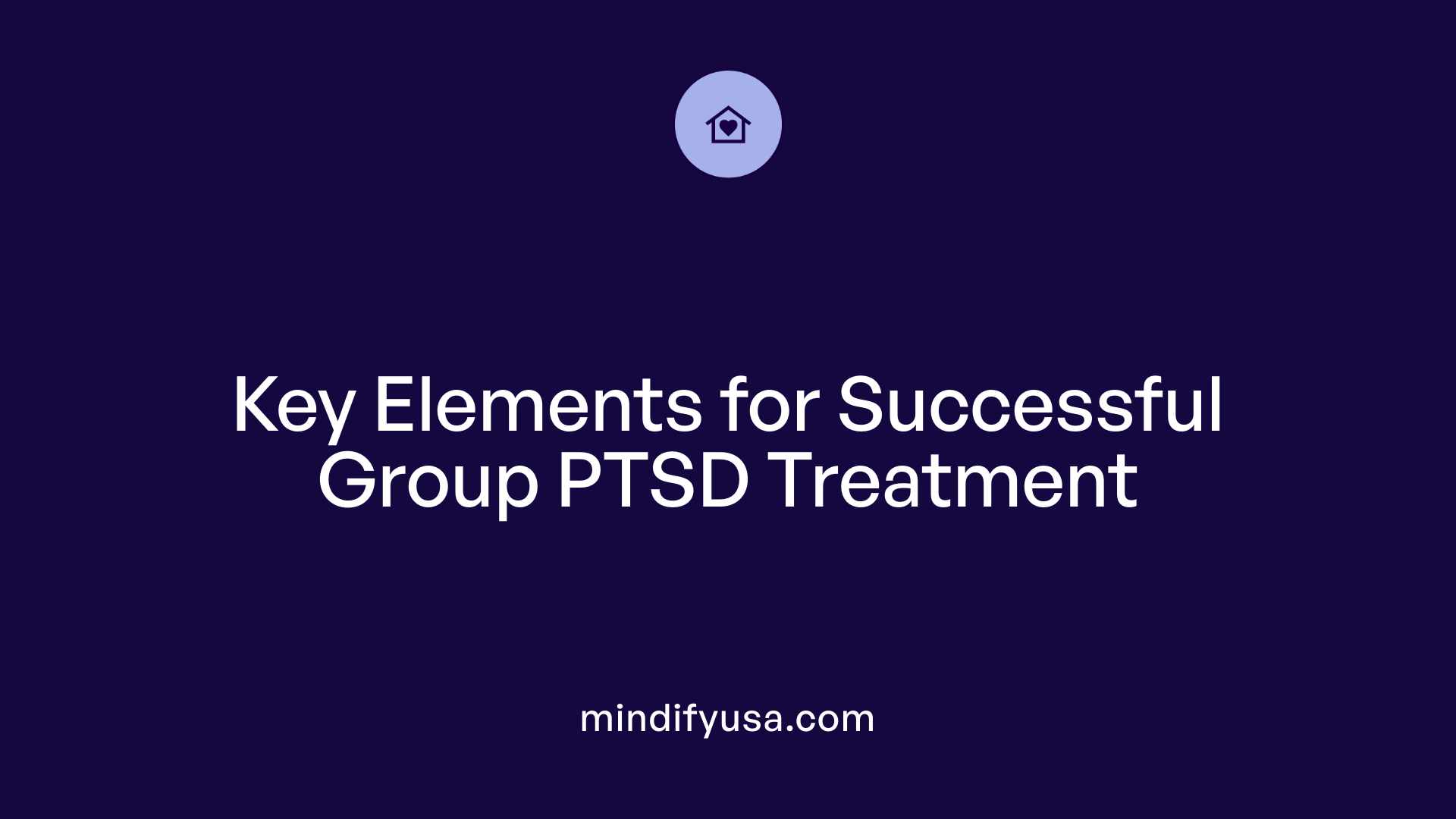
What factors influence the success of group therapy?
The effectiveness of group therapy in aiding the recovery from PTSD relies on a combination of various elements that work together to create a supportive and productive environment. These factors not only facilitate healing but also maximize the benefits participants derive from their shared experiences and learned skills.
One of the primary elements is the degree of group cohesion. When members feel closely connected and supportive of one another, they are more likely to open up and engage fully in the process. This sense of belonging fosters trust and reduces feelings of isolation, which are common among trauma survivors.
Social identification, or the shared feeling of being part of a community with similar experiences, enhances this effect. When participants recognize that others understand their struggles, it diminishes shame and stigmatization, encouraging honest communication.
The therapeutic alliance—the relationship between facilitators and participants—is another critical factor. Skilled therapists who are experienced in trauma-focused approaches like trauma-focused cognitive-behavioral therapy (TF-CBT) or cognitive processing therapy (CPT) can better guide discussions, manage group dynamics, and adapt interventions to meet individual needs. Their expertise helps create a safe environment where difficult memories can be explored without retraumatization.
Participant engagement also plays a significant role. Active involvement in therapy activities, such as sharing personal stories, practicing coping strategies, and giving and receiving feedback, boosts the likelihood of positive outcomes.
Interpersonal dynamics within the group, including the quality of relationships, the presence of positive attachment styles, and mutual respect, influence how well members collaborate and support one another. These dynamics can help reduce feelings of shame and promote emotional safety.
Creating a secure environment is essential. Facilitators must ensure confidentiality, address stigma, and accommodate diverse trauma experiences. This safety enables survivors to confront their trauma constructively.
Additional factors include the structure and size of the group. Smaller groups may allow more individualized attention, while well-structured sessions with clear goals and activities promote consistency and predictability, which are comforting for trauma survivors.
Finally, incorporating ongoing feedback mechanisms allows facilitators to adjust the group process, address emerging issues, and optimize outcomes. Attention to these interrelated elements ensures that group therapy remains responsive and effective for individuals recovering from PTSD.
Practical Implementation and Settings of Group PTSD Therapy
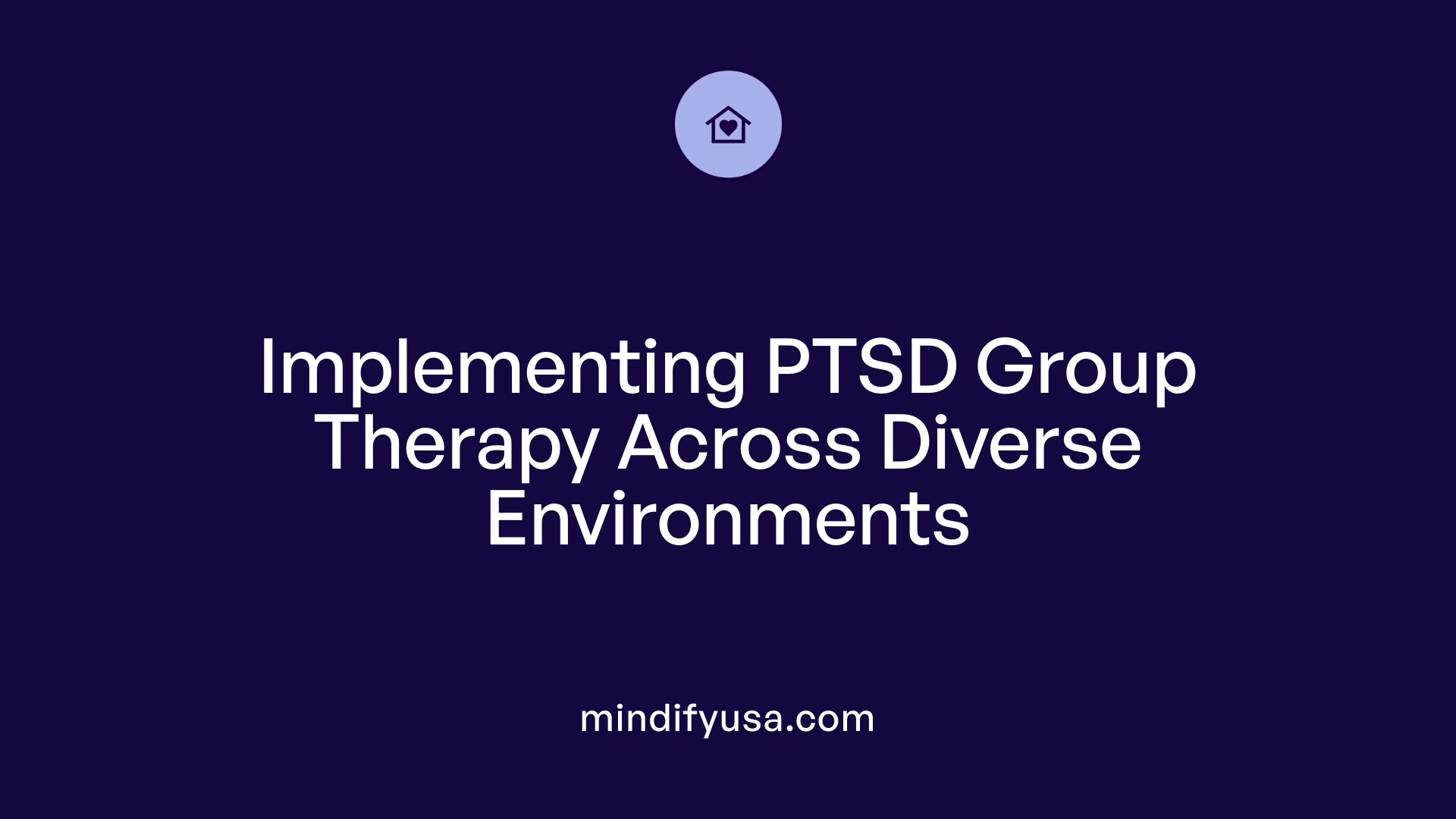
How is group therapy implemented across various settings?
Group therapy for PTSD can be adapted to a wide range of environments, making it accessible to diverse populations. Hospitals and mental health clinics often host structured group sessions led by trained therapists, focusing on evidence-based approaches like Cognitive Processing Therapy (CPT) and Prolonged Exposure (PE). Community clinics and primary care settings offer more accessible options, such as brief trauma information groups like the Trauma Information Group (TIG), which are integrated into general health services.
Veteran centers and specialized clinics frequently run trauma-focused groups tailored to military personnel, veterans, or survivors of specific traumas such as interpersonal violence or combat trauma. Online platforms are increasingly used, providing virtual group sessions that expand reach—especially important during circumstances limiting in-person contact.
Implementing group therapy requires selecting appropriate facilitators skilled in trauma-specific interventions. Group composition plays a crucial role—considering trauma type, gender balance, age, cultural background, and group size helps foster cohesion. Typically, groups are kept small enough to allow meaningful interaction but large enough to offer diverse viewpoints.
Creating a secure space involves establishing clear guidelines about confidentiality, behavior, and participation boundaries. Facilitators often incorporate psychoeducation, storytelling, and skills training within sessions to promote connection, normalize experiences, and teach coping strategies. Regular evaluation and feedback from participants ensure the program adapts to evolving needs, maintaining cultural sensitivity and session relevance.
In primary care, brief, focused interventions like TIG demonstrate promising results, making PTSD management more feasible within general health services. Flexibility in session length, frequency, and structure, along with ongoing facilitator training, are essential for success.
What are the considerations for effective implementation?
Implementing group therapy effectively requires multiple critical considerations to maximize benefits and ensure safety. First and foremost, facilitators must be qualified and trauma-informed—understanding PTSD, trauma responses, and appropriate interventions. They should be skilled in managing group dynamics, emotional crises, and fostering a supportive environment.
Tailoring groups to meet the specific needs of the population enhances engagement and relevance. For example, veteran groups might focus on military-related trauma and resilience, whereas civilian groups might address interpersonal violence or accidents. Such specialization helps build trust and reduces stigma.
Fostering a nonjudgmental, confidential atmosphere encourages openness. Clear ground rules about confidentiality, respect, and participation are vital in building trust within the group. Maintaining an optimal group size—often between 5 to 12 participants—balances diverse perspectives with individual attention.
Integrating psychoeducation about trauma responses, symptom management, and coping skills enhances the therapeutic impact. Evidence-based models like trauma-focused CBT, TMT, or EMDR adapted for groups should be employed, ensuring the approach aligns with participants' needs.
Monitoring progress through feedback mechanisms allows facilitators to adjust the sessions dynamically. Regular assessments help track symptom reductions and skill acquisition. Cultural competence and sensitivity to participants’ backgrounds improve engagement and outcomes.
Finally, ongoing facilitator training, supervisory support, and adherence to best practices help sustain the quality and safety of group therapy programs. Collectively, these considerations build a foundation for effective, responsive, and compassionate PTSD treatment in group settings.
Harnessing Collective Strength for Healing
While individual therapy remains a cornerstone of PTSD treatment, the collective power of group therapy offers unique benefits that can significantly aid recovery. Its capacity to reduce isolation, foster social support, teach coping skills, and normalize trauma responses makes it an invaluable component of comprehensive PTSD treatment. Supported by rigorous research and diverse models, group therapy not only expedites symptom reduction but also empowers survivors to rebuild trust, develop resilience, and find community. As research continues to evolve, integrating tailored group interventions into broader treatment plans will further enhance outcomes and support long-term healing.
References
- Benefits Of Group Therapy Sessions For PTSD | Veterans Affairs
- Find a Trauma and PTSD Support Group - Psychology Today
- PROTOCOL: Group‐based interventions for posttraumatic stress ...
- Implementing group therapy for posttraumatic stress disorder within ...
- Post-traumatic stress disorder (PTSD) - Diagnosis and treatment
- Efficacy of group psychotherapy for posttraumatic stress disorder
- Can PTSD Group Therapy For Trauma Help Me? - BetterHelp
- Group therapy in primary care settings for the treatment of ...
- Group Therapy for Trauma: Is It Effective? - Charlie Health












